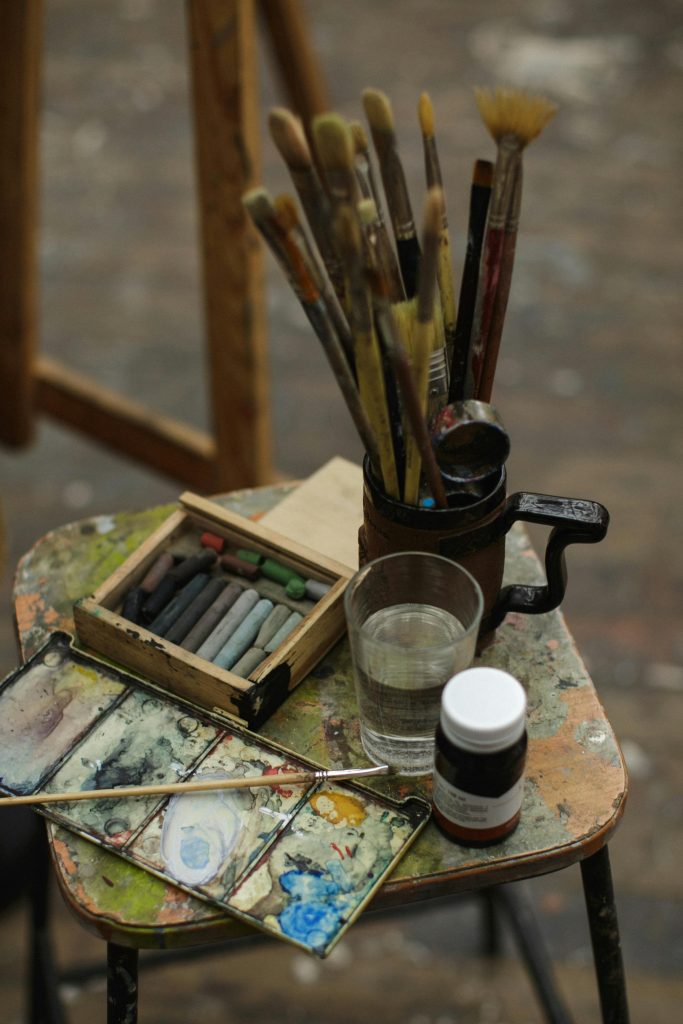How to Add Testimonials to Your Artist Portfolio

(A Personal Guide to Letting Others Speak for Your Art)
As artists, we spend most of our time showing, not telling. We’re used to letting our brushstrokes, lines, and textures speak for us. But in a world where trust sells, and where people want to know what it’s like to work with you, letting others share their words can be just as powerful as showing your work.
That’s where testimonials come in. Thoughtful feedback from buyers, curators, collaborators, or workshop attendees can turn a good portfolio into a magnetic one. The trick is knowing how to present those testimonials so they add to your artistic voice instead of overpowering it. This guide will help you gather, format, and showcase testimonials in a way that feels sincere, visually harmonious, and authentically you.
Let’s Talk About Why Testimonials Actually Matter
If you’re thinking, “Isn’t my art supposed to speak for itself?”, you’re not alone. A lot of artists feel weird about highlighting praise. But here’s the thing: testimonials aren’t just about showing off. They’re about building connection and trust.
Think of it this way: when someone else talks about how your art made them feel, that feedback adds a layer of credibility and emotional weight your images alone might not convey. A viewer might admire your color palette, but when they read that a buyer cried when they hung your piece in their living room? That sticks.
Testimonials can also ease the worries of potential buyers or curators. Are you professional? Easy to work with? Do you meet deadlines? Instead of you saying it (which can feel awkward), someone else can do it on your behalf. That’s social proof at its best.
You don’t need dozens of testimonials to make a difference. Even just three well-placed, honest quotes can make your portfolio feel more lived-in, more human, and more trustworthy. The secret is in how you choose them, and where you place them.

Here’s Where You Can Gently Ask for Testimonials (Without Feeling Pushy)
If the thought of asking someone for a testimonial makes you feel like you’re cold-calling for a sales job, let’s reframe that. People who’ve had a meaningful experience with your art often want to support you. They just need a little guidance.
Start with people you trust: past collectors, gallerists, workshop attendees, or even those who’ve commissioned you. Reach out with a warm, genuine message. Something like, “I’m updating my portfolio and would love to include a short testimonial if you feel comfortable. Just a couple of lines about what stood out for you would be amazing.”
Offer prompts to make it easier:
- What was the experience of working with me like?
- How did the piece make you feel once you had it?
- What surprised you or stood out during the process?
Keep it light, respectful, and low-pressure. If it feels more natural, you can also use a short Google Form or Typeform with one open-ended question. For buyers who’ve already sent you a glowing email or message, ask for permission to quote it directly.
Pro tip: timing matters. The best moment to ask is right after a project is completed or a piece is delivered, while the excitement is fresh and the emotions are still high.
You’ve Got the Words, Now Where Do They Go?
You’ve collected a few beautiful pieces of feedback. Now what? Knowing where to place testimonials is just as important as having them in the first place. They need to feel like part of the journey, not a sidebar.
Start with your About page. This is where people go to learn about the artist behind the work. Placing a testimonial here, especially one that touches on your work ethic or creative spirit, can reinforce your story. It’s like having a friend vouch for you while you introduce yourself.
Next, consider embedding quotes between sections of your artwork. Imagine someone scrolling through your landscape series and coming across a quote like, “Her use of blues transported me to my childhood beach holidays.” That kind of emotional connection can elevate the viewer’s experience.
Feature a few on your homepage if your layout allows. A carousel or sidebar with one-liner testimonials can set the tone right away. Think of it as your visual art plus a voiceover.
And finally, if you’ve got longer testimonials or case-study style feedback, consider creating a dedicated Testimonial or Reviews page. This works especially well if you do a lot of custom work, commissions, or collaborations.
Let’s Make Those Testimonials Look As Good As Your Art
A testimonial can be powerful, but if it’s shoved into a corner with no design love, it might go unnoticed, or worse, look unprofessional. Just like your art deserves clean presentation, so do your words of praise.
Keep quotes short and skimmable. Aim for two or three sentences max. You want viewers to feel something quickly, not wade through a mini-novel. Use quotation marks and keep the font readable, nothing too scripted or decorative.
Visually, testimonials shine when set apart from the rest of the text. Use blocks, italics, or a soft background color. A pale gray box or a light border can do wonders for making testimonials feel like curated moments rather than clutter.
Adding a name and title adds weight. If possible, include a small photo or initials. “Megan L., Gallery Owner” carries more authenticity than a quote left anonymous. That said, always ask permission.
Think of the testimonial layout like designing a mini-painting: balance, breathing room, and clarity are key. You wouldn’t clutter your brushstrokes, don’t crowd your compliments either.
How to Blend Testimonials into Your Portfolio (Instead of Slapping Them On)
Here’s the golden rule: testimonials should feel like part of the rhythm, not a record scratch. You want them to flow with your layout, complementing your art instead of interrupting it.
One great strategy is to interweave testimonials with your artwork. After showcasing a series, drop in a quote that speaks to that exact body of work. It helps the viewer emotionally engage and adds context to what they’re seeing.
You can also pair testimonials with process images or studio shots. If someone complimented your creativity or collaboration, place their quote beside a photo of you working. It creates a full-circle story: here’s what I made, and here’s how it made someone feel.
Avoid dumping all your testimonials into one chunky block. Space them out across your portfolio.
And if you’re worried about overwhelming your layout, go minimal. One powerful quote placed with care can have more impact than five crowded ones. Treat them like visual accents, not main headlines.
If designing layouts stresses you out, you don’t have to do it alone. The Customizable Digital Portfolio Template for Artists lets you drop in your art, bio, and testimonials without touching a single line of code. It’s perfect if you want a clean, testimonial-friendly layout that feels like you, but professionally polished.

Ready to Go Deeper? Try Pairing Testimonials with Mini Case Studies
If you’re doing commissions or custom work, this section’s for you. While short testimonials work wonders, pairing them with mini case studies gives even more context. It’s like a full-circle view of your process and impact.
Start with a photo of the final piece. Add a short paragraph describing the project: who it was for, what the brief was, and any unique challenges or creative twists. Then, under that, include a testimonial from the client.
For example:
Project: A commissioned painting for a meditation studio
Story: The client wanted something calming and spiritually rooted in ocean themes.
Quote: “She listened deeply and translated my vague ideas into something that instantly calms everyone who walks in. It’s the heart of our studio now.”
This trifecta, project context, visuals, and testimonial, builds huge trust. Especially for potential buyers who are nervous about custom work, this kind of clarity can ease fears and encourage commissions.
It also shows off your ability to deliver not just beautiful work, but meaningful experiences.
Quick Tricks and Clever Little Testimonial Cheats You’ll Love
Ready for some behind-the-scenes artist hacks? These testimonial tricks are small but mighty, and they’ll make the whole process easier (and smoother) for you.
1. Screenshot Sweet DMs.
Got a lovely Instagram message or comment? Screenshot it and ask permission to share. These casual, off-the-cuff words often feel the most heartfelt.
2. Voice Notes = Text Gold.
If someone leaves you a glowing voice note, jot it down and write it out. Then check with them if it’s okay to include it on your site.
3. Rotate Quotes.
You don’t have to show every testimonial all the time. Create a rotating section on your homepage or refresh your featured quotes every season.
4. Group Short Ones Together.
Have several quick comments? Stack them into a block like a “love notes” page. It creates a sense of volume without overwhelming readers.
5. Use Their Words in Your Product Descriptions.
A quote like “this painting reminds me of my childhood home” can double as both testimonial and inspiration text under your artwork.
These little cheats don’t just save time, they help you get the most mileage from every bit of feedback.
Don’t Have Any Testimonials Yet? Here’s What You Can Do Right Now
New to the scene? Don’t stress. Everyone starts without testimonials. The good news is, you can gather meaningful feedback even before your first big sale.
Start with your art school peers, instructors, or mentors. Their impressions of your dedication, creativity, or growth can still carry weight, especially if they’ve seen your process up close.
Consider offering a few free or discounted commissions in exchange for thoughtful feedback. Be transparent, clear, and make sure their experience feels valuable. These early testimonials often end up being the most meaningful because they come from a place of trust.
If someone on Instagram leaves a meaningful comment, “Your work always lifts my mood”, DM them to ask if you can quote it.
And don’t be afraid to use your own reflections at first. A short line under your artwork like, “This piece helped me process my own grief” isn’t a testimonial, but it’s honest and connective. It invites the viewer to feel alongside you.
Testimonials Should Grow With You, So Keep Them Fresh
Your portfolio isn’t a fossil, and neither are your testimonials. As your work evolves, so should the voices that represent it. That’s why regular updates matter.
Build a habit of checking in every few months. Did you complete a new commission? Host a workshop? Sell a piece? That’s your window to ask for a fresh quote while the memory is still warm.
Archive older testimonials in a separate section or rotate them out to keep your portfolio light and current. Quotes from 2018 might still be relevant, but they shouldn’t be the only ones on your site.
And if someone’s professional status changes, maybe a collector now runs a gallery, update their title. That detail can boost your perceived credibility without you lifting a finger.
Think of your testimonial section like a garden. Water it. Prune it. Let it bloom with your growth.
Let Their Words Add Soul to Your Story
In the end, a testimonial isn’t just a compliment. It’s a memory someone had with your art. A moment of transformation. A little echo of impact. And that’s worth including in your portfolio, not as bragging rights, but as a gentle reminder of why your work matters.
Let your art speak, but let others speak with it. Carefully chosen testimonials can warm your layout, ease viewer hesitation, and build emotional bridges you couldn’t craft with images alone.
So don’t think of it as self-promotion. Think of it as storytelling, layered with lived experience. Because in the beautiful, vulnerable, chaotic life of an artist, nothing beats hearing that your work touched someone else deeply.
